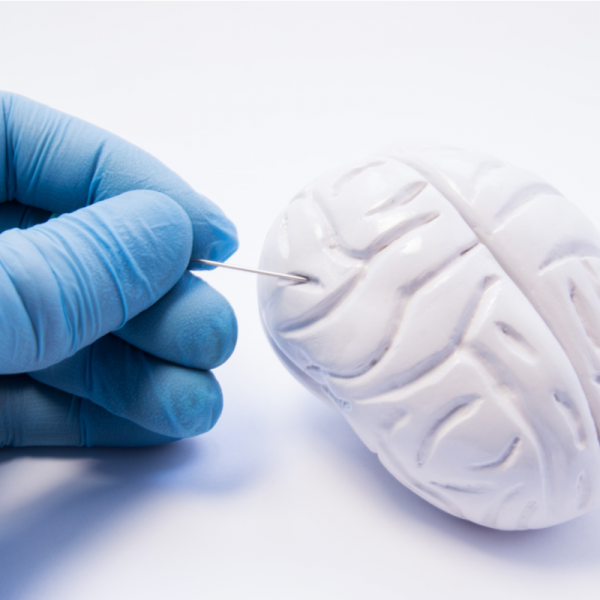
What is a glioma?
The term glioma refers to a type of brain tumour that develops from the supporting cells of the nerve tissue (glial cells). A glioma is classified into the following different tumour types, depending on which glial cells it originates from:
- Astrocytomas: star-shaped cells with sometimes long cell processes, which are among the most common gliomas, accounting for more than 60 per cent,
- Oligodendrogliomas: Cells with short processes, which account for 10 per cent of all gliomas,
- Ependymomas: ventricles in the brain, which account for 5 to 10 per cent of all gliomas,
- Mixed gliomas: such as oligoastrocytomas, which account for 5 to 10 percent of all gliomas.
A glioma can either be surgically removed or treated with radiotherapy and/or chemotherapy. The chances of cure vary depending on the type of glioma. While less malignant (low-grade) gliomas can be treated, others are incurable. Glioma is the most common type of primary brain tumour, affecting an average of five to six out of every 100,000 people each year. While some types of glioma tumours develop in childhood, other types of tumours do not develop until adulthood.
What are the different types of glioma?
Gliomas, like other brain tumours, are classified by the World Health Organisation (WHO) into so-called tumour grades according to their growth and prognosis:
- I. Grade: Pilocystic astrocytoma; these are benign and slow-growing tumours that usually have a good prognosis and can be removed by surgery
- Grade II: Diffuse astrocytoma (fibrillary, gemistocytic, pilomyxoid, protoplasmic); oligodendroglioma; oligoastrocytoma; tumours which have a high risk of recurring after successful treatment (recurrence) and can develop into malignant tumours,
- III. grade: Anaplastic astrocytoma; anaplastic oligodendroglioma; anaplastic oligoastrocytoma; are malignant tumours which require radiation and/or chemotherapy in addition to surgery,
- IV. Grade: Glioblastoma: are very malignant tumours that grow rapidly and have an unfavourable prognosis. Even with the available treatment methods of surgery, radiation and/or chemotherapy, glioblastomas are usually not curable.
Glioblastoma is the most common, followed by the various forms of astrocytoma. Oligodendroglioma is the rarest form of brain tumour. Low-grade gliomas occur more often in children and younger adults, while adults and older people are more likely to develop high-grade gliomas.
What causes a glioma?
Doctors still disagree about the causes of brain tumours. However, they assume that a glioma can develop due to genetic factors. These include, above all, neurofibromatosis I or tuberous sclerosis. But radiation therapy, for example, which was carried out to treat a previous cancer, can also promote the growth of a glioma.
Brain tumours are caused by disturbed physiological cell division, which takes place daily in the form of metabolic activities in every cell and also in the genetic material, the DNA. If the DNA is damaged during these processes, mutations or defective DNA sections can form. As a result, these degenerate cells can multiply uncontrollably, giving rise to diseased tissue (neoplasia).
What are the symptoms of a glioma?
A glioma, like many other brain tumours, manifests itself quite late. Which symptoms occur and how noticeable they are always depends on the location of the tumour. At first, a glioma can manifest itself as constantly recurring headaches, dizziness, nausea and vomiting. Depending on its location, however, it can also cause behavioural and sensory disorders such as tingling as well as visual and speech disorders. Furthermore, seizures can even occur, which indicates increasing intracranial pressure.
How is a glioma diagnosed?
Glioma is diagnosed by means of magnetic resonance imaging (MRI). To be able to determine the glioma even more precisely, a tissue examination (biopsy) is also carried out. Since the glioma consists of so-called glial fibres, these can be detected in a tissue sample by colour-marking the glial fibre protein (GFAP). In this way, it is also possible to distinguish between other brain tumours, as they each contain different proteins.
How is a glioma treated?
The type of treatment always depends on the severity of the respective glioma, its size and localisation. In general, a glioma can be treated with surgery, radiation and/or chemotherapy. Along with these treatment methods, the patient also receives psychological care.
When choosing a suitable treatment method, the doctor will always assess the risks and benefits. In general, the doctor will always try to remove the tumour completely by surgery. The most important post-operative treatment is usually radiotherapy. Alternatively, systemic drug therapies can be used, in which substances from the field of cytostatics and anti-angiogenesis play a major role.
If a glioblastoma is present, it can be treated using so-called tumour treating fields (TTF). In this treatment method, a bonnet is placed on the patient through which magnetic fields are generated. These magnetic fields are supposed to inhibit the cell growth of the tumour. The effectiveness of tumour treating fields has already been proven in medical studies, which is why it should always be considered as a treatment option for glioblastoma.
What are the chances of curing a glioma?
In addition to the severity of the tumour, the prognosis also depends on the patient's age and general health. It is true that the prospects of complete cure decrease with increasing age and disease state. The 5-year survival rate after diagnosis is about 20 percent, regardless of the sex of the person concerned. For successful treatment, especially of malignant gliomas, early diagnosis and initiation of appropriate treatment is always important, as these types of tumours always grow quickly.
